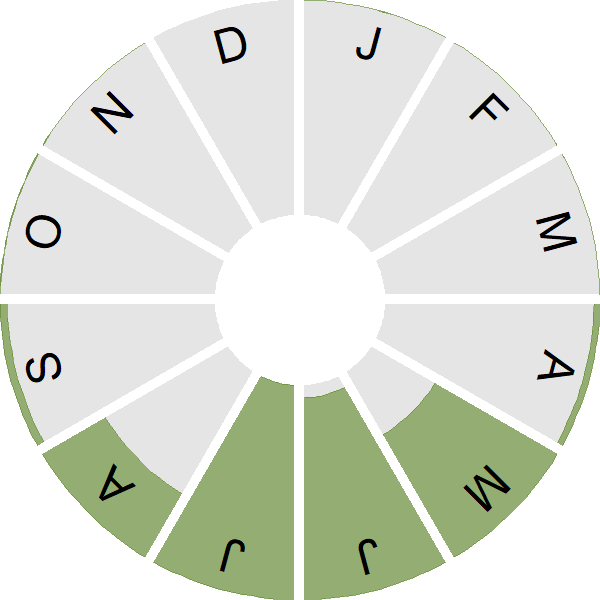Swift
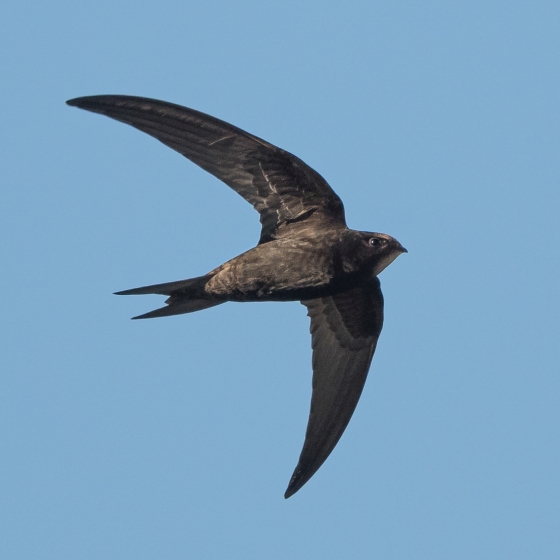
Introduction
Swift is the long-distance migrant most associated with people, as it chooses to nest amongst our urban dwellings.
We await the return of Swifts to Britain and Ireland in early May and they are given the accolade of bringing the summer with them. Written about in poetry and prose, the dark scythe-winged silhouettes of Swifts wheeling about in a blue sky are often accompanied by their screaming calls.
Although widespread across much of Britain & Ireland, Breeding Bird Survey data have documented a significant decline in their populations. The reasons for these losses are likely to include poor summer weather, a decline in their insect food and continued loss of suitable nesting sites.
- Our Trends Explorer gives you the latest insight into how this species' population is changing.

Key Stats
Identification
ID Videos
This section features BTO training videos headlining this species, or featuring it as a potential confusion species.
Hirundines & Swift
GBW: Swift, Swallow and House Martin
Songs and Calls
Call:
Flight call:
Status and Trends
Conservation Status
Population Change
Swifts were not monitored before the inception of the BBS. Their monitoring is complicated by the difficulty of finding occupied nests, by the weather-dependent and sometimes extraordinary distances from the nest at which breeding adults may forage, and by the often substantial midsummer influx of non-breeding individuals to the vicinity of breeding colonies. Since Swifts do not normally begin breeding until they are four years old, non-breeding numbers can be large. BBS results indicate that steep declines have occurred in England, Scotland and Wales since 1995. Many Swifts seen on BBS visits will not necessarily be nesting nearby, however, and the relationship between BBS transect counts and nesting numbers has not yet been investigated. The BBS map of change in relative density between 1994-96 and 2007-09 indicates that decrease has been widespread, with some limited increases in parts of Wales and western Britain. On the strength of the BBS decline, Swift was moved from the green to the amber list of conservation concern in 2009 (Eaton et al. 2009) and then to the red list in 2021. A moderate decrease has been recorded in the Republic of Ireland since 1998 (Crowe 2012). Numbers across Europe have been broadly stable since 1980 (PECBMS: PECBMS 2020a).
Distribution
Swifts have a broad breeding distribution, with higher densities in warm, dry areas such as East Anglia, and lower densities in northern and western regions. In Britain & Ireland they nest almost exclusively in buildings and distribution and abundance maps show a close match to the built environment, with concentrations in towns and cities.
Occupied 10-km squares in UK
or view it on Bird Atlas Mapstore.
or view it on Bird Atlas Mapstore.
European Distribution Map
Distribution Change
In Britain the overall number of occupied 10-km squares has shown little change, but in Ireland there has been a 26% range contraction since the 1970s.
Change in occupied 10-km squares in the UK
or view it on Bird Atlas Mapstore.
or view it on Bird Atlas Mapstore.
Seasonality
Swifts are summer visitors, arriving from late April with birds gradually departing from mid July; most birds usually departed by mid September but odd birds can appear even as late as November.
Weekly pattern of occurrence
The graph shows when the species is present in the UK, with taller bars indicating a higher likelihood of encountering the species in appropriate regions and habitats.

Habitats
Breeding season habitats
Relative frequency by habitat
The graph shows the habitats occupied in the breeding season, with the most utilised habitats shown at the top. Bars of similar size indicate the species is equally likely to be recorded in those habitats.
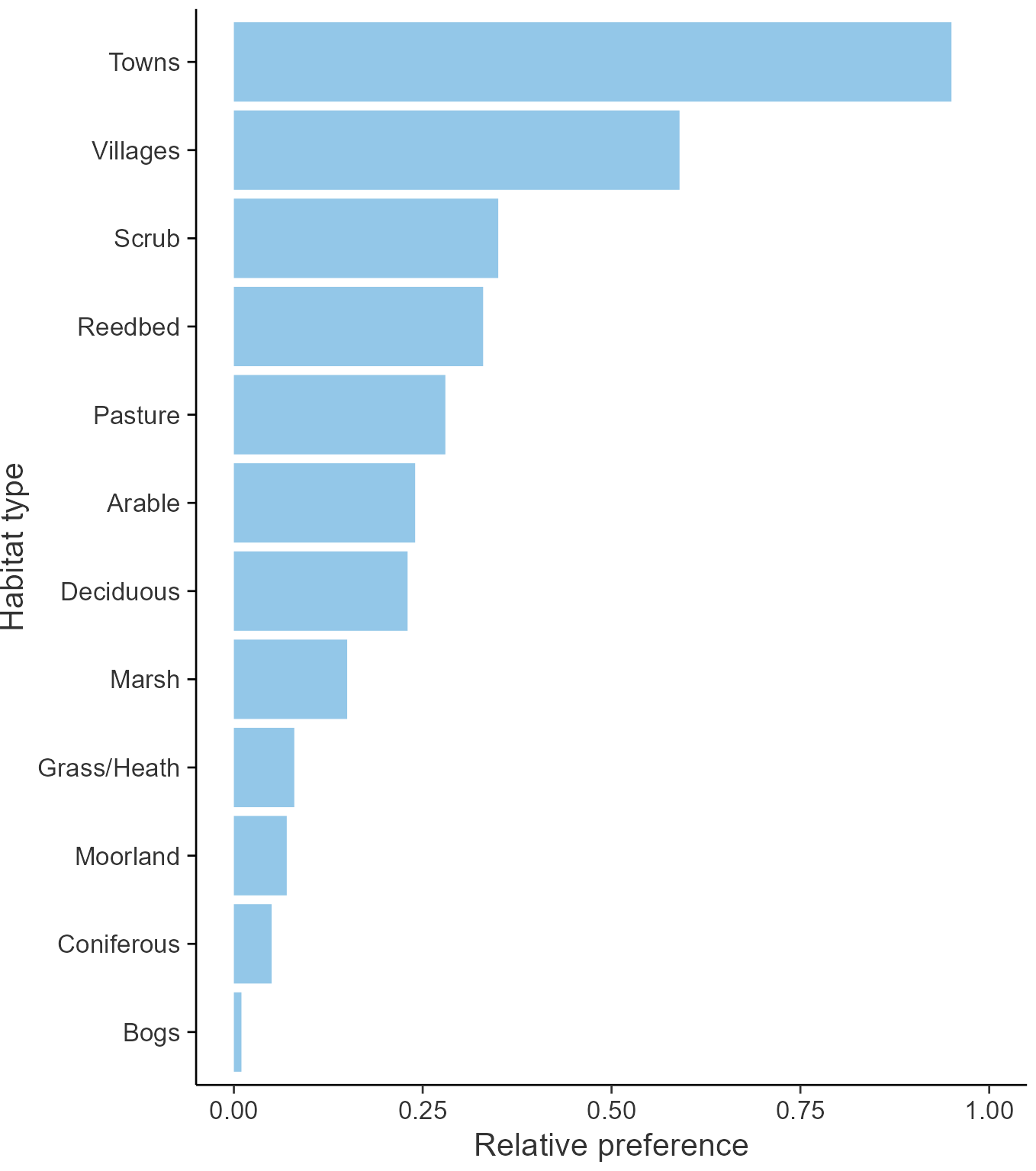
Movement
Britain & Ireland movement
Foreign locations of birds ringed or recovered in Britain & Ireland
Dots show the foreign destinations of birds ringed in Britain & Ireland, and the origins of birds ringed overseas that were subsequently recaptured, resighted or found dead in Britain & Ireland. Dot colours indicate the time of year that the species was present at the location.
- Winter (Nov-Feb)
- Spring (Mar-Apr)
- Summer (May-Jul)
- Autumn (Aug-Oct)

European movements
EuroBirdPortal uses birdwatcher's records, such as those logged in BirdTrack to map the flows of birds as they arrive and depart Europe. See maps for this species here.
The Eurasian-African Migration Atlas shows movements of individual birds ringed or recovered in Europe. See maps for this species here.
Biology
Productivity and Nesting
Nesting timing
Egg measurements
Clutch Size
Survival and Longevity
Survival is shown as the proportion of birds surviving from one year to the next and is derived from bird ringing data. It can also be used to estimate how long birds typically live.
View number ringed each year in the Online Ringing Report.
lifespan
Survival of adults
Biometrics
Wing length and body weights are from live birds (source).
Wing length
Body weight
Ring Size
Classification, names and codes
Classification and Codes
- Order: Apodiformes
- Family: Apodidae
- Scientific name: Apus apus
- Authority: Linnaeus, 1758
- BTO 2-letter code: SI
- BTO 5-letter code: SWIFT
- Euring code number: 7950
Alternate species names
- Catalan: falciot negre
- Czech: rorýs obecný
- Danish: Mursejler
- Dutch: Gierzwaluw
- Estonian: piiritaja e. piirpääsuke
- Finnish: tervapääsky
- French: Martinet noir
- Gaelic: Gobhlan-mòr
- German: Mauersegler
- Hungarian: sarlósfecske
- Icelandic: Múrsvölungur
- Irish: Gabhlán Gaoithe
- Italian: Rondone comune
- Latvian: svire
- Lithuanian: juodasis ciurlys
- Norwegian: Tårnseiler
- Polish: jerzyk (zwyczajny)
- Portuguese: andorinhão-preto
- Slovak: dáždovník obycajný
- Slovenian: hudournik
- Spanish: Vencejo común
- Swedish: tornseglare
- Welsh: Gwennol Ddu
- English folkname(s): Devil Bird, Martlett
Research
Causes of Change and Solutions
Causes of change
The causes of the decline are unclear, although a recent analysis of BTO monitoring data (Finch et al. 2023) suggests that changes in juvenile (but not adult) survival are the most likely driver of the decline.
Further information on causes of change
Analysis of phenological change suggests that Swifts both arrive and depart in the UK earlier than in the 1960s, with the length of stay consequently remaining unchanged (Newson et al. 2016). Low juvenile survival appeared to be associated with poor weather conditions (Finch et al. 2023), implying a reduction in availability of aerial insects was causing additional mortality. Modern building design and refurbishment of old buildings are likely also have contributed to the decline by depriving Swifts of nest sites, but the complications in monitoring trends and nests (as described in the Status Summary) make it difficult to confirm the primary drivers of change.
Information about conservation actions
This species is difficult to monitor and hence the main drivers of the decline are uncertain. Given confirming the cause of decline is challenging and likely to remain so for some time, it would be prudent to take some precautionary actions whilst research is ongoing.Provision of additional nesting space to counter any reductions in availability of nest sites as a result of modern building designs and refurbishment of older buildings, either in the form of Swift nestboxes and Swift bricks which can be integrated into new buildings and renovations, as supported by Action for Swifts, Swift Conservationand similar organisations, are a relatively straightforward and inexpensive conservation action which can be taken by local groups and individuals, and can also be incorporated into wider development planning. Swifts are known to use these artificial nests (e.g. Schaub et al.2015). The availability of nest sites could also be increased on a wider scale by implementing policies or regulations which encourage or legislate the provision of nest boxes or Swift bricks on new buildings. Swift Towers are another option which have been used in Europe. Further information and advice about providing boxes and attracting Swifts to them is available on the Swift Conservationwebsite.
Swifts can forage over an extremely wide area during the breeding season, so other conservation actions such as habitat management in the vicinity of nest sites (to attempt to increase the availability of prey) are unlikely to be successful, unless they can be undertaken on a wider landscape scale. Whilst actions to increase levels of invertebrates across the wider countryside may benefit Swifts, further research is required, both to confirm whether changes to invertebrate abundance might be a cause of the Swift decline, and if so to identify the habitats which will provide the optimal requirements for foraging Swifts.
Publications (7)
Spatial variation in spring arrival patterns of Afro-Palearctic bird migration across Europe
Author: Border, J.A., Boersch-Supan, P., Pearce-Higgins, J.W., Hewson, C., Howard, C., Stephens, P.A., Willis, S.G., Houston, A., Gargallo, G. & Baillie, S.R.
Published: 2024
The timing of migrant birds’ arrival on the breeding grounds, or spring arrival, can affect their survival and breeding success. The optimal time for spring arrival involves trade-offs between various factors, including the availability of food and suitable breeding habitat, and the risks of severe weather. Due to climate change, the timing of spring emergence has advanced for many plants and insects which affects the timing of maximum food availability for migratory birds in turn. The degree to which different bird species can adapt to this varies. Understanding the factors that influence spring arrival in different species can help us to predict how they may respond to future changes in climate.
02.05.24
Papers

Birds of Conservation Concern Wales 4: the population status of birds in Wales
Author: Johnstone, I.G., Hughes, J., Balmer, D.E., Brenchley, A., Facey, R.J., Lindley, P.J., Noble, D.G. & Taylor, R.C.
Published: 2022
The latest review of the conservation status of birds in Wales. The report assessed all 220 bird species which regularly occur in Wales. There are now 60 species of bird on the Red List, with 91 on the Amber List and just 69 - less than a third of the total number of species - on the Green List.
06.12.22
Reports Birds of Conservation Concern

Demography of Common Swifts Apus apus breeding in the UK associated with local weather but not aphid abundance
Author: Finch, T., Bell, J.R., Robinson, R.A. & Peach, W.J.
Published: 2022
Data from the BTO/JNCC/RSPB Breeding Birds Survey reveal that breeding Swift populations in the UK are in decline. Both reductions in the availability of invertebrate prey and the loss of nesting sites have been suggested as possible reasons, but the ultimate drivers of this decline are poorly understood. Can we improve our understanding of Swift decline by bringing together the information collected by bird ringers and nest recorders alongside data on insect availability and weather?
03.11.22
Papers
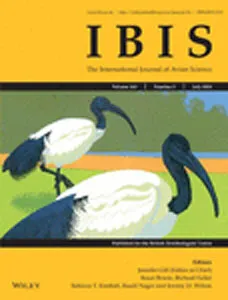
A 30,000-km journey by Apus apus pekinensis tracks arid lands between northern China and south-western Africa
Author: Zhao, Y., Zhao, X., Wu, L., Mu, T., Yu, F., Kearsley, L., Liang, X., Fu, J., Hou, X., Peng, P., Li, X., Zhang, T., Yan, S., Newell, D., Hewson, C. M., Townshend, T., Åkesson, S., and Liu, Y.
Published: 2022
The Swift is widely distributed with a cross-continental breeding range spanning Europe and large parts of Asia and north Africa. Until recently, Swift migration research has focussed on populations which breed in Europe and north-western Africa (the apus subspecies), leaving the migration of birds breeding throughout Asia (the pekinensis subspecies) shrouded in mystery.
29.06.22
Papers
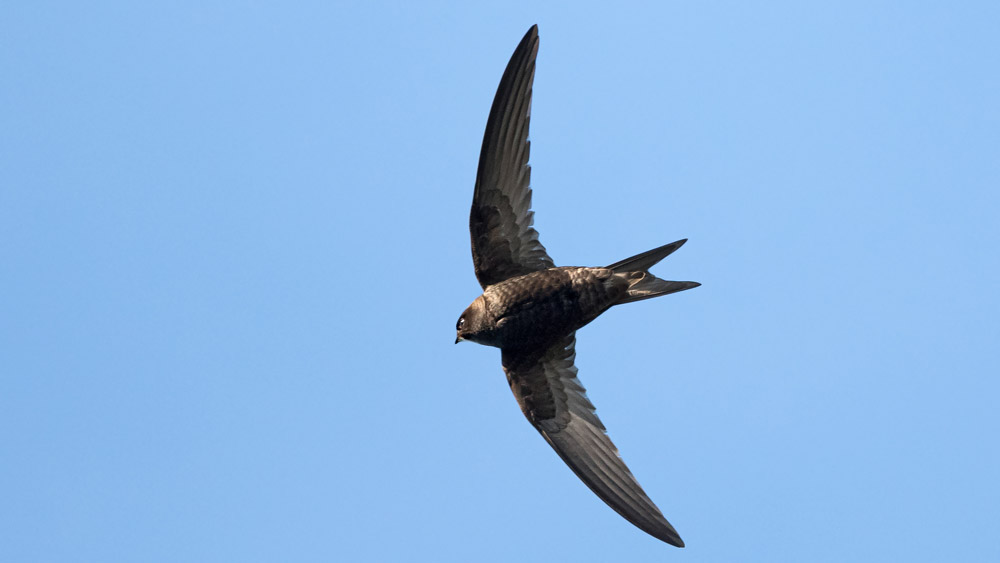
The status of our bird populations: the fifth Birds of Conservation Concern in the United Kingdom, Channel Islands and Isle of Man and second IUCN Red List assessment of extinction risk for Great Britain
Author: Stanbury, A.J., Eaton, M.A., Aebischer, N.J., Balmer, D., Brown, A.F., Douse, A., Lindley, P., McCulloch, N., Noble, D.G. & Win, I.
Published: 2021
Commonly referred to as the UK Red List for birds, this is the fifth review of the status of birds in the UK, Channel Islands and Isle of Man, published in December 2021 as Birds of Conservation Concern 5 (BOCC5). This updates the last assessment in 2015. Using standardised criteria, experts from a range of bird NGOs, including BTO, assessed 245 species with breeding, passage or wintering populations in the UK and assigned each to the Red, Amber or Green Lists of conservation concern.
01.12.21
Reports Birds of Conservation Concern
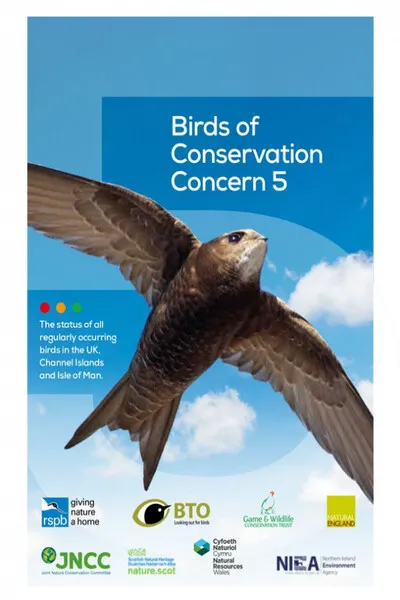
Evolution of chain migration in an aerial insectivorous bird, the Common Swift Apus apus
Author: Åkesson, S., Atkinson, P.W., Bermejo, A., de la Puente, J., Ferri, M., Hewson, C.M., Holmgren, J., Kaiser, E., Kearsley, L., Klaassen, R.H.G., Kolunen, H., Matsson, G., Minelli, F., Norevik, G., Pietiäinen, H., Singh, N.J., Spina, F., Viktora, L. & Hedenström, A.
Published: 2020
The highly aerial Common Swift Apus apus, which spends the non‐breeding period on the wing, has been found to exhibit a rarely‐found chain migration pattern.
04.09.20
Papers
Identification of putative wintering areas and ecological determinants of population dynamics of Common House-Martin Delichon urbicum and Common Swift Apus apus breeding in Northern Italy
Author: Ambrosini, R., Orioli, V., Massimino, D. & Bani, L.
Published: 2011
To identify the causes of population decline in migratory birds, researchers must determine the relative influence of environmental changes on population dynamics while the birds are on breeding grounds, wintering grounds, and en route between the two. This is problematic when the wintering areas of specific populations are unknown. Here, we first identified the putative wintering areas of Common House-Martin (Delichon urbicum) and Common Swift (Apus apus) populations breeding in northern Italy as those areas, within the wintering ranges of these species, where the winter Normalized Difference Vegetation Index (NDVI), which may affect winter survival, best predicted annual variation in population indices observed in the breeding grounds in 1992–2009. In these analyses, we controlled for the potentially confounding effects of rainfall in the breeding grounds during the previous year, which may affect reproductive success; the North Atlantic Oscillation Index (NAO), which may account for climatic conditions faced by birds during migration; and the linear and squared term of year, which account for nonlinear population trends. The areas thus identified ranged from Guinea to Nigeria for the Common House-Martin, and were located in southern Ghana for the Common Swift. We then regressed annual population indices on mean NDVI values in the putative wintering areas and on the other variables, and used Bayesian model averaging (BMA) and hierarchical partitioning (HP) of variance to assess their relative contribution to population dynamics. We re-ran all the analyses using NDVI values at different spatial scales, and consistently found that our population of Common House-Martin was primarily affected by spring rainfall (43%–47.7% explained variance) and NDVI (24%–26.9%), while the Common Swift population was primarily affected by the NDVI (22.7%–34.8%). Although these results must be further validated, currently they are the only hypotheses about the wintering grounds of the Italian populations of these species, as no Common House-Martin and Common Swift ringed in Italy have been recovered in their wintering ranges.
01.01.11
Papers

